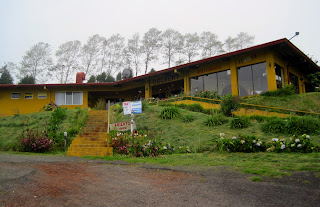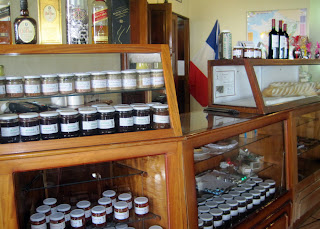 |
| Lake Caliente, Poás Volcano |
To capitalize on accrued air miles to score one free roundtrip flight, we were obliged to fly out of Austin. Sigh. Austin is a six hour drive from BPV RV Park! But, when Dennis and Kate Stalzer (blog readers will recall our April 2012 weekend bike ride adventure) who live in Austin learned of our plans, they insisted we drive up a day early and overnight at their home. Not only did they put us up for the night, they dropped us at the airport the next morning and garaged our truck at their house!
 |
| thank you Delta baggage handlers |
The rest of our tour group, having arrived earlier that day, were already tucked into their beds by the time we made our way into the Hotel Bougainvillea bar to celebrate our arrival. Clink! A traditional margarita toast to birding in Costa Rica.
 |
| hotel grounds |
 |
| Lynn was often heard saying, "It's not snowing!" |
 |
| Rufous-naped Wrens were quite inquisitive and vocal |
Monday March 11 was the first official day of the tour. Following breakfast we met our driver, Didier, and boarded our tour bus for a day trip to Poás Volcano. Poás is an active stratovolcano that has erupted 39 times since 1828. We hoped it would hold off erupting again for a bit longer, at least while we were there.
 |
| Lake Botos, Poas Volcano |
 |
| Blue-crowned Motmot |
Near the summit of Poás there are two lakes. The northern lake, Laguna Caliente, is one of the world’s most acidic lakes and supports little or no aquatic life. The bottom of the lake is covered with a layer of liquid sulphur causing acidic gases and fog to rise from the lake impacting the surrounding ecosystems while providing irritation to the eyes and lungs of visitors to Poás. A half hour hike took us to a second crater lake near the summit. Lake Botos, in sharp contrast to Lake Caliente, was filled with cold, clear water.
Poás was near the epicenter of a 6.1 magnitude earthquake in January 2009 that severely affected surrounding villages causing massive loss of property and some lives. Because the volcano is surrounded by cloud forest, clear views of the crater are often obscured by low clouds. Fortunately for us, the skies remained clear although later in the morning as we departed, clouds had begun to descend and obscure the main caldera and views of most of the volcano.
 |
| Restaurant Colbert |
 |
| Carol and Joel |
Late afternoon found us back at the Hotel Bougainvillea for our evening meal, then packing for our next day’s journey to Mawamba Lodge. The lodge, located on a narrow strip of land between the main channel of the Tortuguero River and the Caribbean Sea, is reached by either a lengthy combined bus and boat ride, or, by taking a short in-country flight. We had opted for the latter in order to maximize our time at the lodge.
 |
| Close quarters on our Nature Air flight |
 |
| Vicki and Lynn |
 |
| dónde está Tortuguero |
 |
| approach over canals at Toruguero |
 |
| launch ride to Mawamba Lodge |
The park’s 22-mile coastal zone is nesting grounds for several species of turtles including Hawksbill, Loggerhead and Leatherback. Endangered Green Sea Turtles also use this area for breeding. Away from the beach, interior rivers and canals are home to caimans, crocodiles, Basilisk lizards and three species of monkey: Geoffery’s Spider, Mantled Howler, and White-headed Capuchin.
 |
| pool at Mawamba Lodge |
 |
| our lodging in cabins |
 |
| Geoffery's Spider Monkey drinking water from bromeliads |
 |
| "Mind where you step," says the Iguana |
 |
| Mawamba Park trail |
 |
| Three-toed Sloth |
 |
| Bronzy Hermit |
The best way to experience the national park was mostly through a network of freshwater creeks and lagoons. The next morning we again were scouring the aquatic landscape on a small launch, this one operated by Daryl Loth, a Canadian friend of Richard’s who owns and operates a nearby B and B (Casa Marabella). Daryl was well versed in local flora and fauna which he shared as we cruised the main river and canals which were flanked by banak, mangrove, and ceiba trees. It became readily apparent how easily it would be to become lost and disoriented.
 |
| on Daryl's boat |
 |
| before entering the park all boats had to purchase a sticker |
 |
| Bare-throated Tiger-Heron and a Basilisk |
 |
| Caiman - keep your hands in the boat |
 |
| on the river again |
 |
| Anita and Marge toasting to all the life birds they added |
 |
| plenty of options |
 |
| waiting to depart Mawamba Lodge |
 |
| there goes our luggage |
The boat’s captain, wishing to recover the dislodged and no doubt expensive cover, turned the boat around and retraced the route for a few miles before giving up. Headed up river once more the delay had put us behind schedule. It was quite a ride - water spraying and engines roaring while we careened around sharp bends. I’m sure everyone wondered where we might wind up if the engines couldn’t keep up with the current should we hit more snags. Still, in the midst of the wild ride, some of the group spotted Green Ibis off the port side of the boat. A life bird at between 20-25 knots!
 |
| Caño Blanco disembark |
We were happy to see Didier and be back on solid ground as we struck off to find lunch and bird our way to our next destination: Almonds and Corals.
 |
| Squirrel Cuckoo |
 |
| a birder's delight |
 |
| White-eared Ground-Sparrow |
 |
| aerial shot of agriculture |
 |
| Basalisk |
 |
| Social Flycatcher |


















No comments:
Post a Comment